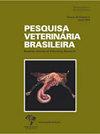Efficacy of disinfectants to inactivate H1N1 influenza A virus isolated from pigs
IF 0.8
4区 农林科学
Q3 VETERINARY SCIENCES
引用次数: 0
Abstract
ABSTRACT: The aim of this study was to access the efficacy of four disinfectants to inactivate influenza A [H1N1] 0 hour and 72 hours after disinfectant dilution. A pandemic H1N1 influenza virus isolated from a pig with respiratory disease was used to obtain inoculums containing 6.4log10 EID50/mL; 5.4log10 EID50/mL; 4.4log10 EID50/mL and 3.4log10 EID50/mL. Suspension test was composed of 400μL of viral inoculum, 100μL of organic load and 500μL of each individually diluted disinfectant and incubated for ten minutes of contact time. After a neutralizing step, each mixture was filtered on a 0.22μm membrane and 0.2mL was inoculated in six 9-day-old embryo chicken egg through allantoic route. The allantoic fluid from eggs was harvest for RT-PCR and hemagglutination test. The experiment was repeated 72 hours after disinfectant dilution. On the first assessment with fresh disinfectant, influenza virus was inactivated by oxidizing compost disinfectant and phenolic disinfectant in all virus concentrations, the quaternary ammonium compound (QAC) and glutaraldehyde association inactivated the virus up to a concentration of 5.4log10 EID50/mL. QAC disinfectant did not eliminate virus viability. Seventy-two hours after disinfectants were diluted, oxidizing compost disinfectant and QAC and glutaraldehyde association disinfectant demonstrated the same result as the evaluation with fresh disinfectant solution. Phenolic disinfectant inactivated viral inoculum up to a concentration of 5.4log10 EID50/mL. QAC had no effect on inactivating 3.4log10 EID50/mL of influenza virus. In conclusion, three of the four disinfectants tested were effective to inactivate pandemic H1N1 influenza virus in the presence of organic load. Test result performed 72hours after disinfectant dilution suggest a decrease in the effectiveness of one disinfectant.消毒剂灭活猪源甲型H1N1流感病毒的效果
摘要:本研究旨在观察4种消毒剂稀释后0小时和72小时对甲型H1N1流感病毒的灭活效果。采用从呼吸道疾病猪身上分离的H1N1流感大流行病毒,获得含6.4log10 EID50/mL的接种疫苗;5.4 log10 EID50 /毫升;4.4log10 EID50/mL和3.4log10 EID50/mL。悬浮试验由400μL的病毒接种物、100μL的有机负荷和500μL的单独稀释消毒剂组成,孵育10分钟的接触时间。中和后,用0.22μm膜过滤,0.2mL经尿囊法接种于6个9日龄胚鸡蛋中。取卵尿囊液进行RT-PCR和血凝试验。消毒液稀释后72h重复实验。采用新鲜消毒剂对流感病毒进行第一次评价,在所有病毒浓度下,氧化堆肥消毒剂和酚类消毒剂均能灭活流感病毒,季铵盐化合物(QAC)和戊二醛结合力灭活流感病毒的浓度可达5.4log10 EID50/mL。QAC消毒剂不能消除病毒活力。消毒液稀释72 h后,氧化堆肥消毒液和QAC -戊二醛联合消毒液的评价结果与新鲜消毒液评价结果一致。酚类消毒剂灭活病毒接种浓度可达5.4log10 EID50/mL。QAC对3.4log10 EID50/mL流感病毒无灭活作用。综上所述,在有机负荷存在的情况下,4种消毒剂中有3种对大流行性H1N1流感病毒灭活有效。在消毒剂稀释72小时后进行的测试结果表明,一种消毒剂的有效性有所下降。
本文章由计算机程序翻译,如有差异,请以英文原文为准。
求助全文
约1分钟内获得全文
求助全文
来源期刊

Pesquisa Veterinaria Brasileira
农林科学-兽医学
CiteScore
1.30
自引率
16.70%
发文量
41
审稿时长
9-18 weeks
期刊介绍:
Pesquisa Veterinária Brasileira - Brazilian Journal of Veterinary Research (http://www.pvb.com.br), edited by the Brazilian College of Animal Pathology in partnership with the Brazilian Agricultural Research Organization (Embrapa) and in collaboration with other veterinary scientific associations, publishes original papers on animal diseases and related subjects. Critical review articles should be written in support of original investigation. The editors assume that papers submitted are not being considered for publication in other journals and do not contain material which has already been published. Submitted papers are peer reviewed.
The abbreviated title of Pesquisa Veterinária Brasileira is Pesqui. Vet. Bras.
 求助内容:
求助内容: 应助结果提醒方式:
应助结果提醒方式:


